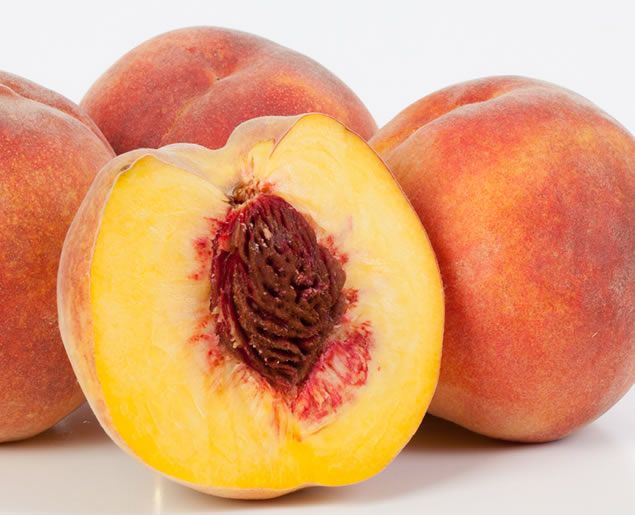Varieties & Approximate Harvest Dates



Richmay
Availability: June 20-30Richmay are the “Firstfruits of the peach season”, starting about 5 days before Flamin’ Fury 1. They are the “blood orange” of peaches with a red flesh and exceptional early-season flavor. Clingstone.
Flamin' Fury® PF1
Availability: June 26-July 8The first of the "Redhaven cousin" line of Flamin' Fury peaches, Flamin' Fury® PF1 is an early-season peach you can depend on to get your first “bowl of peaches” for the season. Clingstone.
Gala
Availability: July 5-15Not to be confused with Gala apples, this juicy, early-season peach will give you one more reason to smile and shout in July! Clingstone.
Sentry
Availability: July 4-14All-around early season winner - disease resistant, our largest early season peach, firm-fleshed until fully ripened, great flavor. Clingstone.
Desiree
Availability: July 5-15It's all in the name - this is a desirable peach. Great color and flavor to match. Clingstone.
Glenglo
Availability: July 7-15Semi-freestone, signals the end of early peach season. Flavor similar to Red Haven with exceptional texture. Clingstone.
Saturn
Availability: July 20-August 5Nicknamed "donut peach" for its peculiar shape, this variety introduces a novel way to eat a peach. Packed with flavor, Saturn is a "must-try"! Clingstone.
Red Haven
Availability: July 20-August 5A legacy variety - an old, venerable favorite that used to be our "best-seller by a landslide", and it's still in high demand by peach canning enthusiasts.
Flamin' Fury® PF9
Availability: July 20-August 5One of the first freestone peaches with outstanding qualities similar to Red Haven. Clair Kauffman, our orchard manager, vouches for this peach as an alternative to Red Haven.
Contender
Availability: July 26-August 6Exceptionally flavored peach with dependable and consistent sweetness. Fans say it has superior texture in the canning jar.
John Boy II
Availability: July 26-August 6A sister to “John Boy.” Pleasant melting texture and classic summer peach flavor. An outstanding canner.
White Lady*
Availability: July 26-August 11Outstanding, very firm white peach with delicious, mild flavor.
Coral Star
Availability: July 27-August 22Large and beautiful with wonderful flavor, this is one of the better cultivars for freezing.
Flamin' Fury® PF17
Availability: July 30-August 15Receives rave reviews from customers who've told us it is the best freestone canning peach they have found. Although lacking in color, many think it is superior to the popular and highly-colored Red Haven.
Sunhigh
Availability: July 30-Aug 15There may be prettier peaches, but few with more exceptional qualities for canning or freezing. Sunhigh is one of our three most popular varieties.
Klondike White*
Availability: August 5-15A new white variety that is surely worth a try!
Loring
Availability: August 5-15A classic traditional peach for canning and freezing. An old favorite, and there’s a reason – its flavor is just simply hard to beat!
Sugar Giant*
Availability: August 15-25Similar to White Lady, but harvested about three weeks later.
Madison
Availability: August 15-30Light orange color with distinctive smooth texture and "peachy aroma", Madison was developed in President James Madison's home state of Virginia. One of the sweetest varieties grown here at Kauffman Orchards, it is easier to peel than many varieties, and is a popular choice for canning by Lancaster County peach enthusiasts.
Blake
Availability: August 21-31Introduced by the New Jersey Ag Experiment Station many years ago, Blake remains an important late-season peach.
Messina
Availability: August 25-Sept. 5A highly-flavored, highly-colored, exceptionally juicy freestone variety that is receiving high marks from many growers in the Mid-Atlantic region.
Flamin' Fury® PF27
Availability: August 25-Sept. 5Very attractive freestone variety with the firm texture typical for a late-season variety. A winner on the peach stand for late-August.
Flamin' Fury® PF28
Availability: August 25-September 5Unusually well-colored for a late-season peach and has hot-season flavor in a cooler-season ripening window.
Flamin' Fury® PF35
Availability: August 29-September 10At a time when we're all dreading the end of fresh peaches until next year, this freestone variety is perfect for stocking up on fresh peaches for one last time.
*The varieties with asterisks (*) are white-fleshed peach varieties.
